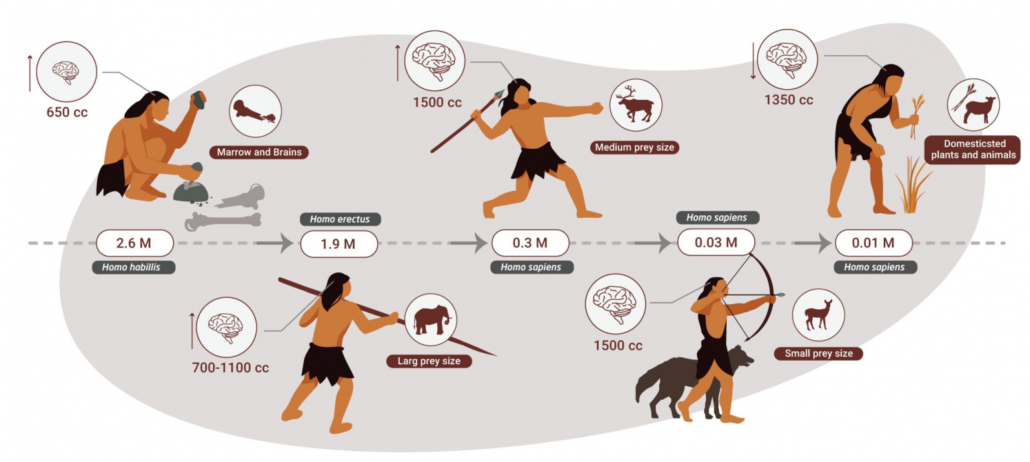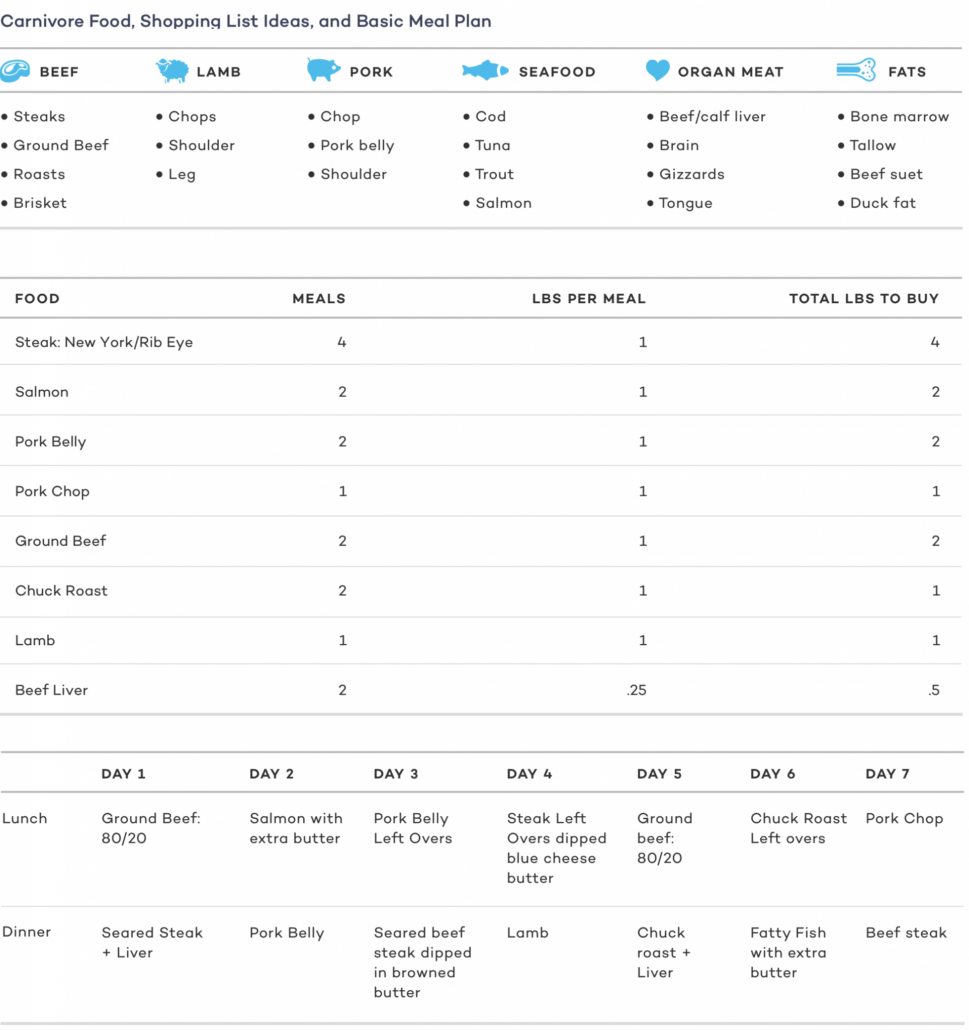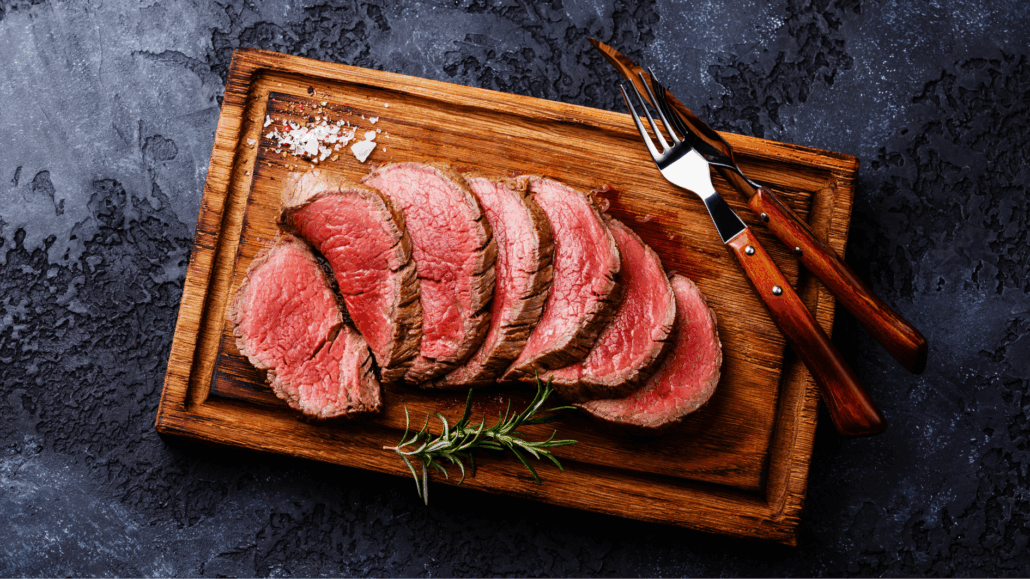We include products in articles we think are useful for our readers. If you buy products or services through links on our website, we may earn a small commission.
The Keto Carnivore Diet: Research, Benefits, and How to
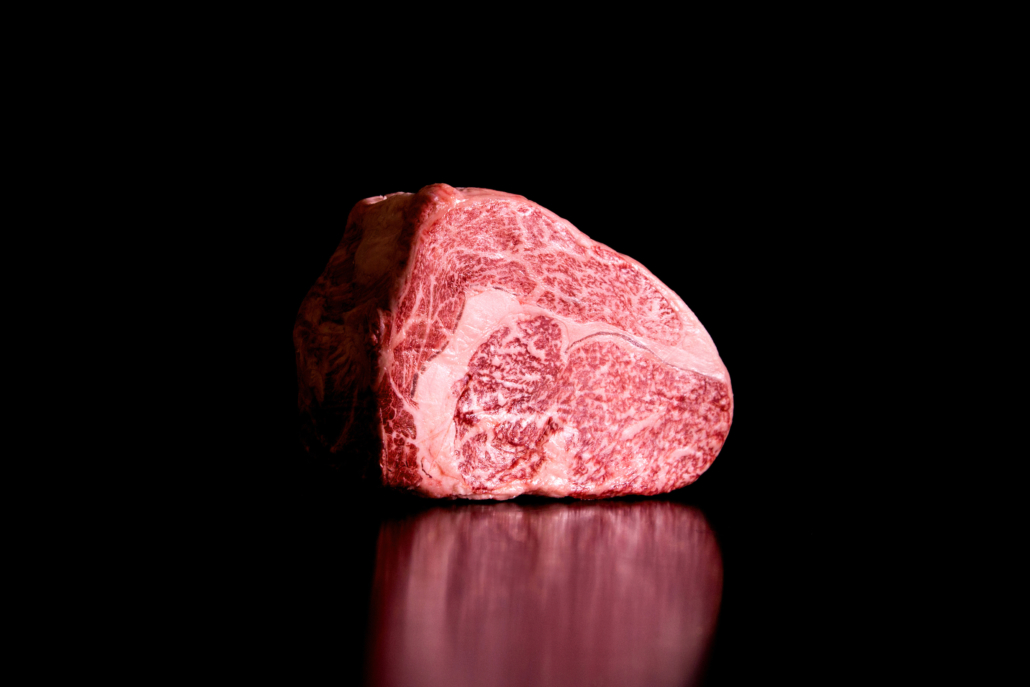
The keto carnivore diet is exactly what it sounds like– a combination of ketogenic macronutrient ratios with a carnivore eating plan.
This means eating only animal products while getting at least 70% of your calories from animal fats.
A keto carnivore way of eating resets the gut microbiome, supplies your body with highly bioavailable nutrients, and reduces inflammation by eliminating plant toxins and antinutrients, excess carbs, and toxic seed “vegetable” oils.
Let’s dig into the keto carnivore diet by exploring what it is, its benefits, and how to do it safely and sustainably.
Table of Contents
What is Keto Carnivore?
Keto carnivore combines high-fat, low-carb, moderate protein macro ratios with an all-meat or all-animal product diet.
Standard ketogenic macro percentages call for
- At least 70% of your calories from fat
- Between 20-30% of calories from protein
- Up to 10% from carbs
A standard keto diet is generally high in animal meats and fats, and low in plant foods, though it allows for some low-carb fruits and veggies. This is because animal products are naturally very low in carbs while providing an abundance of healthy protein and fats. Fruits and veggies, on the other hand, are generally low in fat and high in carbs.
The carnivore keto diet takes this standard keto macronutrient (fat, protein, carbs) ratios and applies carnivore diet rules calling for only animal products while eliminating all plant foods.
Humans Are Keto Carnivores by Nature
Research suggests that keto carnivore is the evolutionarily aligned version of both keto and carnivore.
Eliminating all plant foods and eating mostly animal fat may sound extreme in the context of a high-carb Standard American Diet.
However, researchers like Miki Ben-Dor and Amber O’Hearn make a strong case that keto carnivore is the way our caveman ancestors ate, and therefore evolved on, for nearly two million years.
Source: Dr Miki Ben Dor
Here are a few of the key points supporting the view that humans are keto carnivores by nature.
- Numerous lines of research show that for most of human existence, our ancestors were hyper-carnivorous apex predators that focused on hunting giant fatty animals (megafauna) until their demise around 10,000 years ago 1
- Humans were responsible for eating these giant, fatty animals.
- The caloric return on hunting and eating fatty meat is exponentially higher than collecting fruits and nuts
- Only since the dawn of agriculture some 10,000 years ago have humans incorporated plant foods into our diets in any significant way
- The bodies of modern humans are physiologically identical to the bodies of our fat-loving ancestors
- The bodies of agricultural people are smaller, weaker, and more diseased than pre-agricultural people
- The human body has the propensity to store fat (as energy) that is unique among mammals
- Humans can easily enter ketosis (metabolizing fat into energy molecules) during mundane, calorically replete states, not just starvation states, which makes us, unlike other predators. In other words, ketosis is a natural state for us.
- We have massive, energy-hungry brains that consume large amounts of dietary fat from the moment we’re born until the day we die
Protein Constraints
The irony of the keto carnivore diet is that if you have a properly formulated carnivore diet meal plan, you are, by default, practicing a keto carnivore diet.
Getting more than 50% of your calories from protein causes protein poisoning. Symptoms include hyperinsulinemia, nausea, diarrhea, and in extreme, prolonged cases, death.
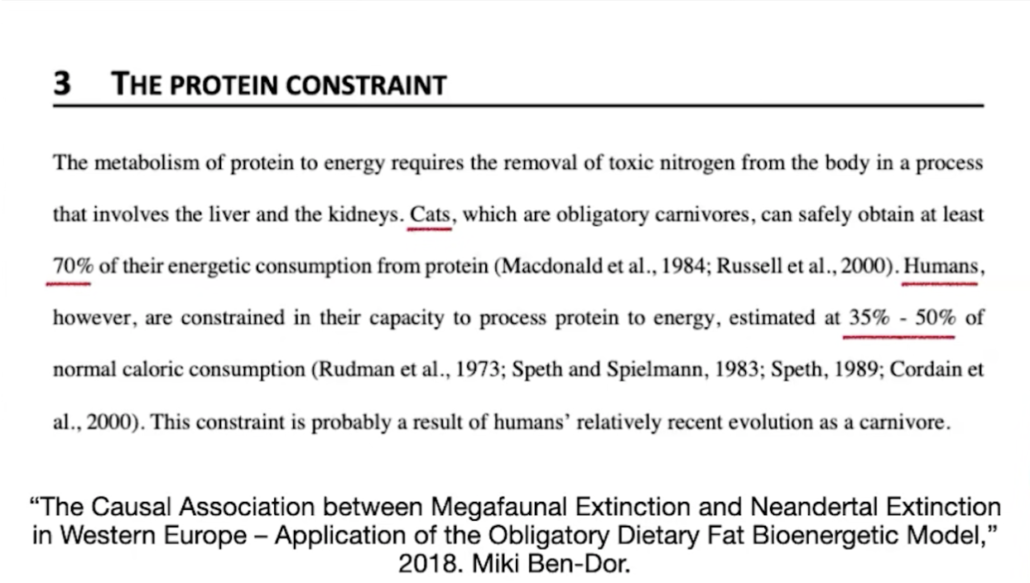
Souce: Amber O’Hearn
Clinically Observed Protein Poisoning on Carnivore

Vilhjalmur Stefansson dragging a seal back to camp. This picture was the cover photo for Stefansson’s book, “The Friendly Arctic,” published in 1921.
Arctic explorer Vilhjalmur Stefansson was one of the first Westerners to try and then champion the keto carnivore diet.
Back in the early 1900s, Stefansson lived with the Inuit in the Arctic where he learned to thrive on a carnivore diet of mostly animal fats.
To demonstrate the benefits of this diet to an incredulous grain-based Western world, he and a friend ate only meat for an entire year under observation at New York’s Bellevue Hospital.
Both men thrived until the researchers had them eat only lean meat. Stefansson describes this shortage of fat as causing “diarrhea and a feeling of general baffling discomfort.”
The good news is that both men quickly reversed these symptoms with a single high-fat meal of brains fried in bacon fat along with sirloin steak.
After this episode of temporary protein poisoning, the observers determined that the ideal carnivore diet macronutrient ratio was 3 parts fat to 1 part protein.
No surprise here–this 3:1 ratio is the foundation of the modern keto diet.
The takeaway: Because of the limits on our ability to process protein, an all-meat carnivore diet is, by biological necessity, a keto carnivore diet.
Benefits of a Keto Carnivore Diet
Though research on the carnivore diet is in its infancy, the keto diet has been clinically studied for nearly one hundred years.
Research shows that a keto diet offers numerous benefits, including
- Improved blood lipid levels.
- Improved insulin sensitivity.
- Reductions in the severity of type 2 diabetes, and fatty liver disease
- Reversal of metabolic syndrome
- Reduces and reverses symptoms of PCOS
- Treatment for numerous types of cancer
- Reduces and slows the progression of neurological disorders like epilepsy, Alzheimer’s and Parkinson’s disease
- Promotes significant weight loss
- More satiating meals reduce cravings for processed and high-carb foods
- Regulates inflammation and supports healthy immune response
- High-fat foods enable your body to absorb fat-soluble vitamins (K, D, E)
- Protects the glycocalyx–a thin membrane over the surface of every cell. It is responsible for overall health, and easily damaged by sugar and carb intake.
Reported Benefits of a Carnivore Diet
Though most of what we know about the benefits of a carnivore diet are self-reported, a quick tour of the #meatheals🥓🍗🍖🥩✌🏻hashtag reveals thousands of inspiring stories of recovery from, and reversal of serious health issues, and dramatic improvements in overall wellbeing.
Reported Carnivore diet benefits include:
- No carb cravings
- Steady energy–no peaks and troughs
- Improved cognition
- Improved mood
- Improved markers of heart health
- Overcoming fertility issues
- Better recovery after exercise
- Clearer skin
- Better digestion
- Reduced inflammation
The study included data from 2,029 people practicing carnivore for at least six months.
Researchers concluded that “Contrary to common expectations, adults consuming a carnivore diet experienced few adverse effects and instead reported health benefits and high satisfaction.”
The study revealed the following statistics:
- 93% improved or resolved obesity and excess weight
- 93% improved hypertension
- 98% improved conditions related to diabetes
- 97% improved gastrointestinal symptoms
- 96% improved psychiatric symptoms
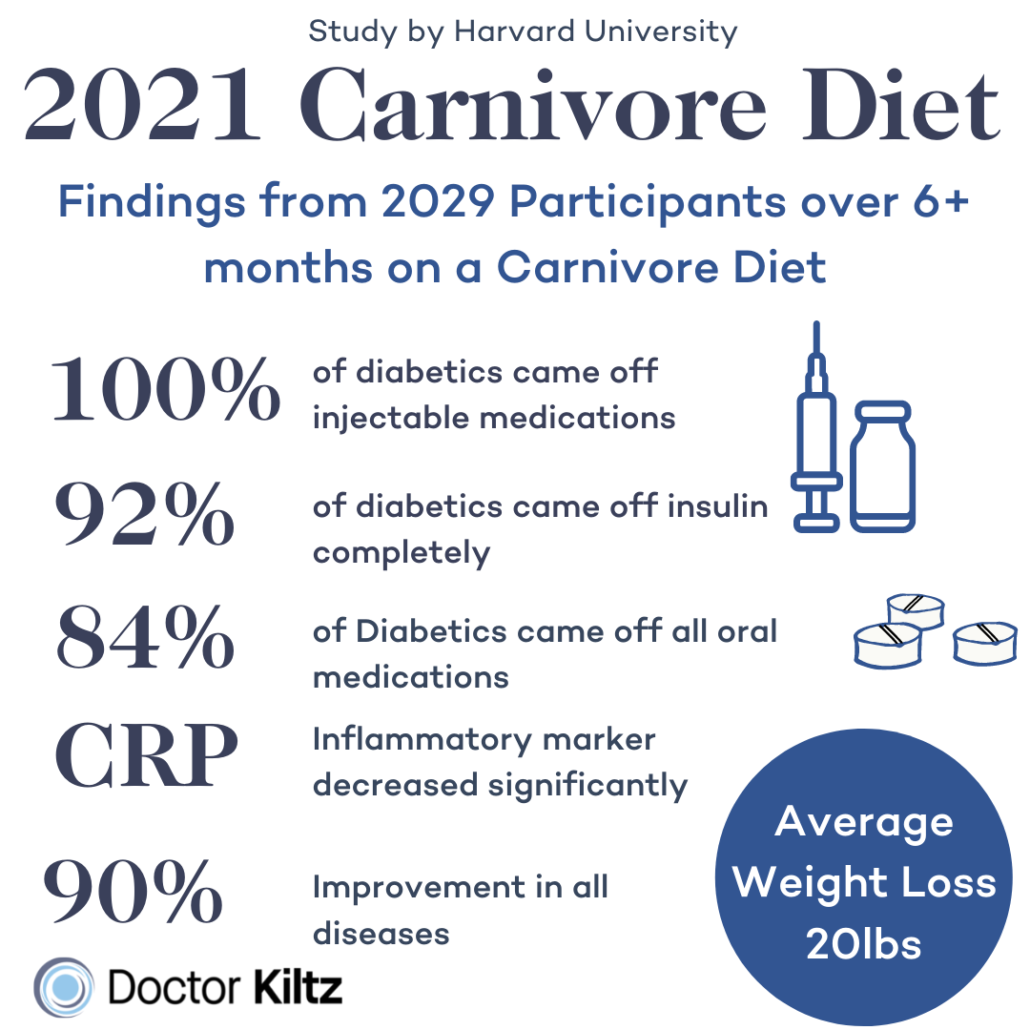
The Harvard study reflected similar findings to a survey by Revero, a carnivore diet coaching service. Examining data from 12,000 people practicing a carnivore diet for at least three months found the following.
- 96% of participants experienced full or significant improvement in all diseases
- 95% improved gastrointestinal conditions
- 96% improved skin allergies and disorders
- 79% eliminated or reduced medications after three months
- 93% improved mental health and mood disorders
- 91% lost weight and reduced body fat
How Keto Carnivore Works
The benefits of a keto carnivore diet can be attributed to two main factors: (1)What you add to your diet. (2) What you eliminate from your diet.
Let’s explore these factors in greater depth.
- Removing inflammatory and irritating foods, including carbs, plant toxins, antinutrients, nightshades, FODMAPS foods, and excess fiber.
- Gut reset. The removal of fermentable fibers and carbohydrates dramatically reduces harmful bacteria. Combined with removing plant toxins, keto carnivore allows the gut lining to heal and promotes the restoration of a healthy microbiome.
- Keto carnivore eliminates ultra-processed, hyper-palatable foods engineered to override satiation signals and keep you eating even when you’re full. Constantly consuming high-carb junk causes hormonal imbalances, leptin resistance, obesity, and inflammatory diseases.
- Animal products are the most nutrient-dense foods on earth. Eating an abundance of fatty meat significantly increases the intake of the micronutrients your body needs for vital for healthy immune response, cognitive ability, emotional regulation, metabolism, and tissue growth.
Animal fats, muscle, and micronutrients are the foundation of healthy cell structures and hormonal regulation.
Plant products, on the other hand, come with a bevy of stressors like excess fiber, carbs, and naturally occurring antinutrients and toxins–all of which damage tissues and promote chronic inflammation–the roots of modern diseases.
Foods to Eat on a Keto Carnivore Diet
The key to a healthy and sustainable keto carnivore diet is to focus on fatty animal foods.
The most nutrient-rich and complete keto carnivore foods are ruminant meats, including fatty cuts of steak, and lamb, preferably from grass-fed sources.
Butter, tallow, lard, creamy cheeses, and eggs are also excellent keto-carnivore staples.
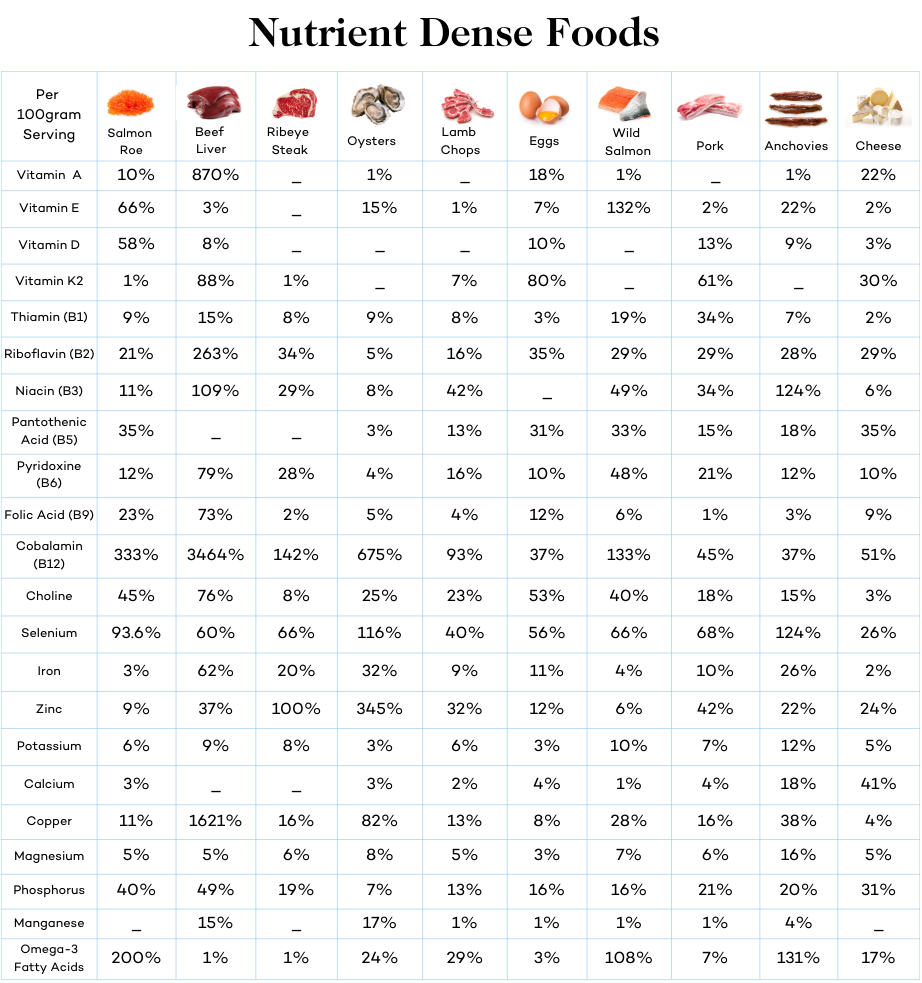
Focus on Fatty Meats
Ribeye steak is the centerpiece of most keto carnivore diets. It’s loaded with healthy fats, proteins, and micronutrients like B vitamins, heme iron, and zinc.
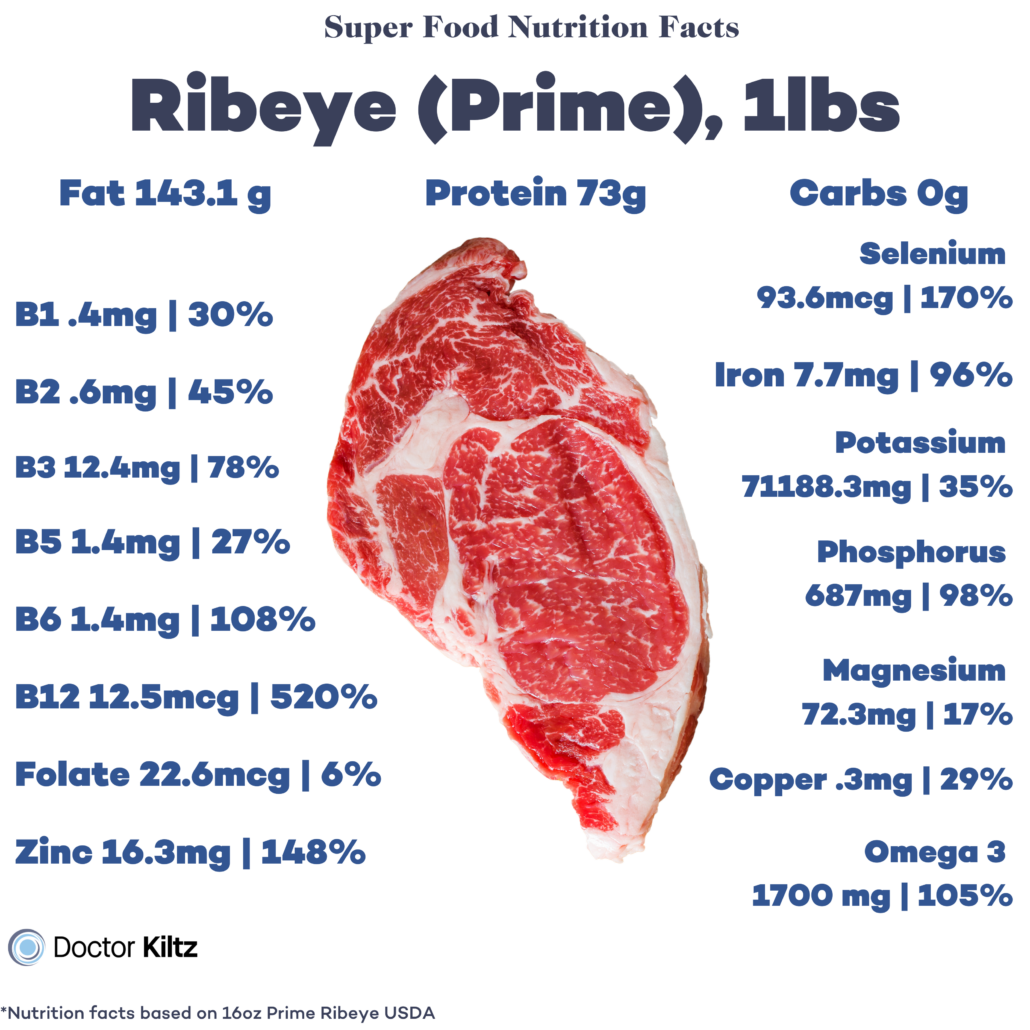
While ground beef, bacon, and pork belly are budget-friendly keto carnivore mainstays packed with whole food fats.
Here’s a list of all-star keto carnivore meats with their fat-to-protein ratios.
| Carnivore Diet Meats | Calories | Fat | Protein | Carbs | %Calories from fat | % Calories from protein |
| Ribeye steak | 310 | 25 | 20 | o | 73% | 26% |
| Pork Belly | 588 | 60 | 10.4 | 0 | 92% | 7% |
| Rack of lamb | 330 | 22 | 30 | 0 | 63% | 37% |
| Sweetbreads | 356 | 33.6 | 14.6 | 0 | 82% | 18% |
| Chicken Wings | 320 | 22 | 30.4 | 0 | 62% | 38% |
Add Fats to your Meals
A tablespoon of tallow, butter, ghee, or lard can bring meals with lean meats like poultry and fish into a keto carnivore macronutrient zone.
Add Fats To Your Beverages
Though coffee is not a true carnivore beverage, most people continue to drink it. And the benefits may outweigh the cons. Boost your fat by adding butter to coffee and tea. You can also make a latte with heavy whipping cream.
The Bottom Line on the Keto Carnivore Diet
The carnivore diet is, by default, a keto carnivore diet. This is because when you cut carbs to nearly zero by eating only animal products, you need to get most of your calories from fat. More than 35% of your calories from protein can lead to protein poisoning–a potentially deadly condition.
The good news is that our bodies are designed to thrive on a keto-carnivore diet. In fact, research tells us that our early human ancestors evolved on a diet of almost exclusively fatty meat for nearly two million years. It was only after we ate most giant fatty animals into extinction that we invented agriculture.
Realigning our physiology with ancestral eating patterns reduces inflammation, protects our digestive systems from plant toxins and excess fiber, balances hormones, and provides the nutrients we need to thrive.











